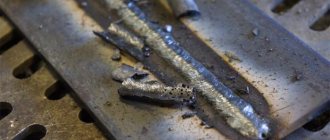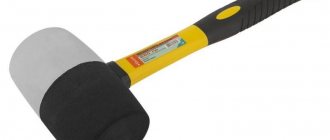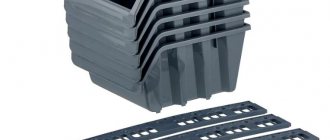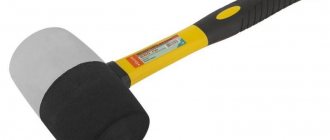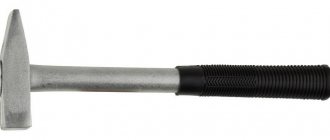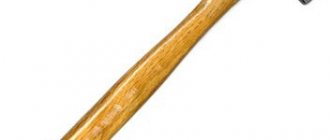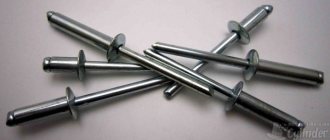The tool needed for carpentry is a mallet. Its name comes from the Old Slavonic concept of “cue,” which was a large wooden club. Modern mallets are made from various materials, they come in different sizes and are widely used by craftsmen of various disciplines. Making a mallet yourself is not that difficult. Its structure is similar to a regular hammer; no special skills are required to create it.
Purpose of the mallet
This instrument is quite heavy, but at the same time it has a soft impact. Why a mallet is needed can be easily explained by those who work with fragile materials (ceramic tiles, plexiglass, etc.) or are involved in dismantling. If you need to apply force without damaging the surface, this is the best tool for this type of work.
The mallet is used to create wooden compositions and interior items during reconstruction. It is also used for its intended purpose in metallurgy: straightening irregularities on thin sheets, straightening the consequences of damage on car bodies. Roofing work also cannot be done without this tool; it is used to process joints and edges. Metal folding is carried out using a mallet. Repairmen use it to lay laminate flooring and assemble furniture. The tool is involved in finishing work on laying tiles and paving stones.
Step 11: Oil coating
To give the wood a rich color I used coconut oil:
- applied it to the hammer using a paper towel;
- Using a hairdryer, I heated the surface so that the oil became more fluid and distributed evenly.
Device and characteristics
The mallet consists of two elements: a handle and a striker.
Essentially, it is a wooden hammer that has a non-standard square shape and a wide striking surface. The assembly drawing of the tool clearly shows what it looks like.
You can create such a product yourself if you use a drill, plane and sanding paper. Its shape can be any: oval, circle, rectangle, etc. The technical parameters of the product contain the dimensions and main structural elements.
Striker and handle material
The handle is made of wood, metal, plastic and fiberglass. In some cases, a special pad is placed on it so as not to damage the hand and not slip during operation. The wooden handle is made from birch or other hardwood. Different types of wood for the handle and striker reduce recoil when performing work. The top of the product is covered with drying oil to prevent drying out.
Striker manufacturing materials:
- Tree. Dense, sticky species: elm, hornbeam, birch.
- Fluoroplastic. High impact resistant plastic. It does not react to the use of chemicals and is not destroyed by water or other solvents.
- Rubber. Solid types are used. Used for easily bendable materials, has a softer impact.
This part of the mallet comes in various modifications.
Striker shape
It depends on the purpose of the tool:
- Rectangle. The mallet is designed for impact work. Often used in conjunction with a chisel for roofing and folding. Her other partner is a chisel.
- Square. Used when working with metal, when laying roofs.
- Circle. The form that has the softest effect on the material is used to straighten the work. Also suitable for installation, installation of paving slabs.
The striking surface can be flat, blunt or wedge-shaped.
Treating the surface
Mix beeswax and mineral oil and treat the item. Our homemade mallet is ready! Now you have a convenient and beautiful handmade tool. Try it out at work!
The most interesting ideas are in your inbox! Subscribe to our newsletter so you don't miss the best solutions. Just enter your email in the form below)
Dimensions and weight of mallets
The tool has a wide range of applications, which causes a range of parameters depending on the work tasks. Heavy models weigh more than 900 g. Standard - 450-900 g. Lightweight - 225-450 g.
It is difficult to determine weight by appearance. Some miniature models are actually heavier than larger mallets. In some products, lead is inserted into the firing pin to ensure the effectiveness of the strike.
Impact force depends on the length of the handle. The longer it is, the harder the instrument hits. Standard parameters of the mallet: weight 300 g, length 30 cm.
Disadvantages of materials - imperfect mallets!
Mallets have a significant drawback - since they are made from a blank with longitudinal fibers, with intensive use, the working part of such a mallet after some time resembles a real washcloth, no matter what type of wood it is made from! The hammer sledgehammer has fewer such problems, however, as already noted, its shape is far from ideal. Taking these two forms as a basis, manufacturers offer us what they consider to be improved tools. For example, a bronze “casing” is put on a turned mallet.
To some extent, the result is a truly durable tool, but the chisels themselves cease to be so! After several visits, they will look exhausted, not the mallet.
. For such a tool you need to buy special, reinforced chisels, which is not always affordable. In this case, it would seem that a rubber mallet would be the ideal option! Of course, it is not all made of rubber - most often, it is a fairly thick layer of material or rubber inserts on the edges of the hammer. Indeed, the impacts are very gentle on the tools, but it is still inconvenient to work - rubber tends to spring back when impacted.
It turns out that there is no ideal mallet? After all, we need to combine qualities that are incompatible in our case:
- convenience;
- durability;
- lack of shock absorption;
- optimal weight.
Manufacturers have not yet proposed an ideal option, but the craftsmen themselves have learned how to make it!
Types of mallets
All existing types of tools involve use for certain tasks:
- Standard - wooden. With its help, carpenters give shape to products. Repairmen dismantle finishing and simple structures. Used in assembling furniture and wooden compositions. There are inexpensive options within 400 rubles. Professional mallets made of durable wood, depending on the size, exceed 2500 rubles. in price.
- Rubber. For brittle coatings that cannot withstand the hard impact of a wood tool. The handle of the rubber striker is made of wood or metal. Lightweight aluminum sheets can only be straightened with rubber mallets. Used for work in auto repair shops, does not damage the coating, does not leave chips. Roofers use it to work with copper and tin parts. There is rubber, but it costs more. The price of a professional tool ranges around 3,000 rubles. There are inexpensive models costing up to 500 rubles. And the options are much more expensive - from 10,000 rubles.
- Inertialess. For the most fragile and thin materials, where accuracy is important. For assembling furniture, glass work, laying decorative tiles. The striker has a built-in metal plate filled with balls or shot. It softens the recoil upon impact. Price on average up to 400 rubles.
- The construction mallet has a wooden handle and a small rubberized striker. This and subsequent ones are special, narrowly focused tools designed for a specific type of activity. Used to work with soft materials and metal-plastic structures.
- The bench is made with a slight reduction in the round handle. The firing pin of this model is rectangular.
- The turning mallet is created on the equipment of the same name.
- Carpentry is used in conjunction with additional tools (chisel and chisel). Its sides are flat, the shape of the striker is flat, polished at one end. It looks like an inverted trapezoid.
- Plastic. The impact part consists of pressed polyethylene and is used for roofing work.
- For tilers, there is a special variety with a round side. For paving stones, the weight of the mallet should not exceed 400 g, so as not to damage it. Paving slabs can withstand up to 800 g.
- Carver's hammer. Small in size, similar to a rolling pin or a tool for cleaning clothes. It is also called a sculptural mallet. Made from expensive wood, cost up to 6,000 rubles.
- Plastic hammer. It has two impact sides and is used in construction and installation.
- Textolite. Small in size, used in jewelry and body work. According to its characteristics, it eliminates the occurrence of static electricity when hitting a surface.
Each of them can be used for different purposes.
GOST 19645-74 Molding mallet with rubber strikers
1 file 142.50 KB
Step you can skip
We will also cut the dowels into the head of our mallet. They do not perform any function other than decorative. When it comes to wood, glue provides a stronger connection than dowels, so they won’t make a difference. But they look beautiful! Drill holes through the striker, apply glue to the dowels and cut them into the striker. After the glue has dried, cut them flush.
How to use a mallet
Despite the apparent simplicity of the tool, the use of a mallet in practice has a number of features:
- Before using it for the first time, you should try to lightly tap the work surface. It is necessary to evaluate the impact force and the degree of load.
- The firing pin must be lowered onto the material being processed with its entire plane. Working with the angle of the tool is unacceptable, otherwise dents will form.
- When doing bodywork or metal work, if you have to straighten a thin sheet, it is recommended to place a hard wooden object under the sheet to ease the effort.
- In combination with a chisel and chisel, the blow should not be too strong. There is a risk of cutting off more material than necessary.
- The tiles are laid with light blows, especially at the corners, to prevent cracks.
The easiest way to learn how to work with a tool that is specially prepared for the hand of the master.
Bringing the surface of the mallet to perfection
Sand the mallet with sandpaper. Admire the work done. If you have a router, you can create smooth curves on the handle at the grip area. If you don't have a router, you can simply sand the edges. You can also make a curve at the end of the handle. Overall, give your piece the look you want.
